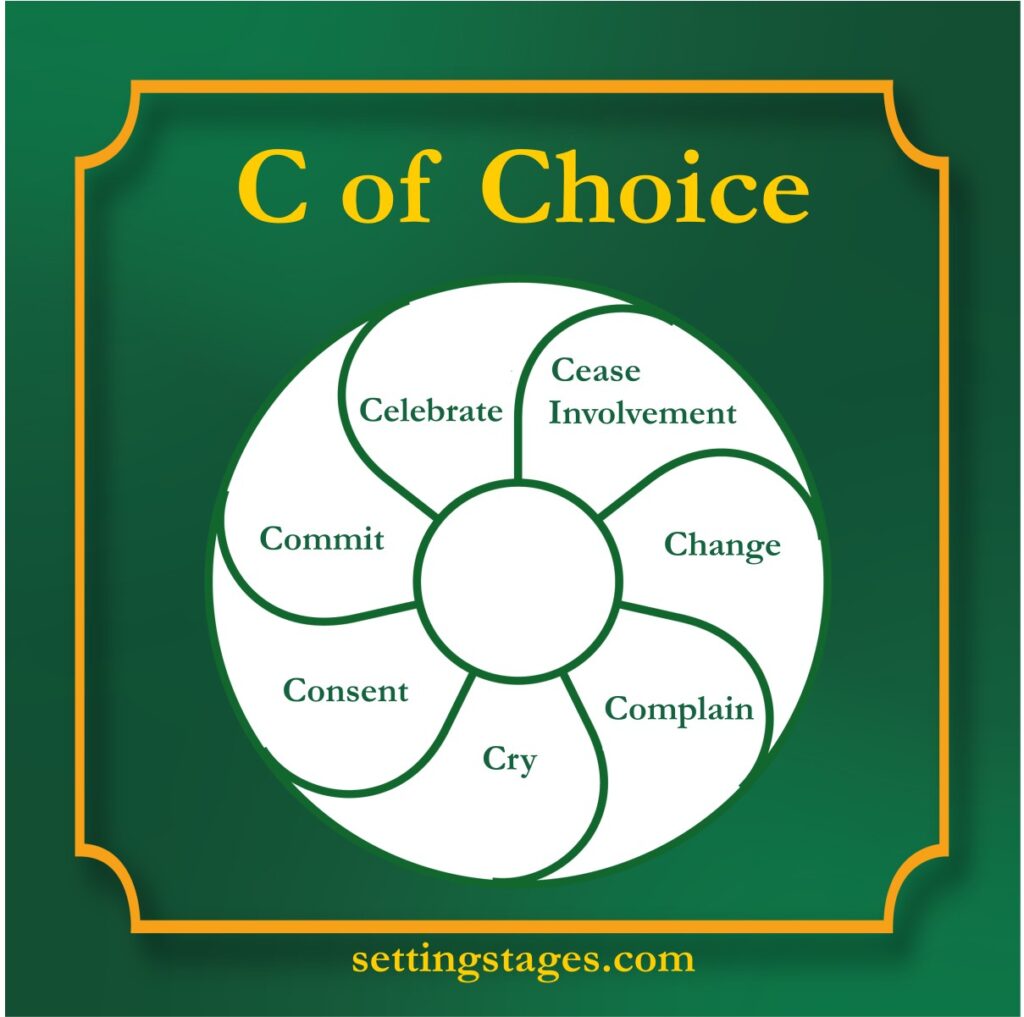Ownership starts with options.
When pressure mounts—deadlines loom, stakeholders push, or priorities shift. It’s easy for teams to feel like passengers rather than drivers. But there’s a powerful truth that often gets overlooked: we always have a choice.
I want to introduce you to a simple yet empowering model: the C of Choice. It’s a tool to help teams pause, reflect, and consciously decide how to respond to the situations they face. It reminds us that ownership doesn’t begin with control over circumstances. It begins with how we respond to them.
The C of Choice model helps teams explore those options with clarity and compassion. Each choice is valid—and knowing them helps us move forward with intention.
Let’s break down the 7 C’s:
- Cease Involvement
- Change
- Complain
- Cry
- Consent
- Commit
- Celebrate

The 7 C’s of Choice
1. Cease Involvement
🛑 “Maybe this isn’t the place for me.”
Sometimes, the bravest and healthiest choice is to walk away. A team member might recognize that their energy, values, or skills no longer align with the situation. This doesn’t mean giving up, it means taking responsibility for your wellbeing and contribution.
✅ When to choose this: If you’ve tried to make it work, but it’s causing harm or blocking your growth.
💡 Team insight: Respect this choice. Explore what could have made it work better.
2. Change
🔁 “What can I do differently?”
Change can take many forms: challenging the process, influencing others, or shifting your own mindset or behavior. It’s an empowered response that says, “I won’t be a bystander.”
✅ When to choose this: When you see opportunities for improvement, and you’re ready to take action.
💡 Team insight: Ask, “What’s in our control to change here, together?”
3. Complain
😤 “This isn’t working for me, and here’s why.”
Complaining gets a bad rap, but constructive complaints can surface hidden tension, unfair expectations, or emotional pressure. It creates transparency. The key is not to stay here too long, but to move forward from it.
✅ When to choose this: When you need to be heard or highlight something that feels off.
💡 Team insight: Listen. Don’t fix right away. Acknowledge the message behind the frustration.
4. Cry
😢 “This is hard, and I feel overwhelmed.”
Let it out. Emotions aren’t weaknesses. They are signals. Crying (or expressing emotion in your own way) clears the path for clarity, connection, and calm. Teams that allow this space are stronger, not softer.
✅ When to choose this: When emotions are blocking your ability to think, act, or connect.
💡 Team insight: Make space for the human side of work. It builds trust.
5. Consent
🙏 “I don’t love this, but I’m okay to go along.”
Consent is a peaceful agreement. It’s choosing to accept reality, not with resignation, but with calm. You may not be thrilled, but you’re willing to proceed. Consent is not the same as passive compliance.
✅ When to choose this: When you’ve considered your options and decide to accept the current path.
💡 Team insight: Ask, “What helps us consent with clarity, not confusion or resentment?”
6. Commit
🔥 “Let’s make this work.”
Commitment means stepping in with both feet. It’s active, not passive. You may not control the challenge, but you own your part in the solution. You invest effort, energy, and intention.
✅ When to choose this: When you feel aligned and ready to act.
💡 Team insight: Talk about what commitment looks like in practice. What’s the first step?
7. Celebrate
🎉 “This is awesome!”
Sometimes, change works. Progress is made. Alignment is found. Don’t let these moments slip by. Celebration builds morale, motivation, and momentum. It reminds us why we do what we do.
✅ When to choose this: When something meaningful has happened, even something small.
💡 Team insight: Pause and reflect: “What do we want to celebrate together?”
Closing Thought: From Reaction to Intention
The 7 C’s of Choice give teams a vocabulary for agency. It’s not about choosing the “right” C, it’s about choosing consciously. And when a team starts naming where they are, they begin shaping where they are headed.
Why These Choices Matter
When teams are unaware of their options, they feel stuck. When they name their choices, they regain agency.
As a leader, facilitator, or team member, bringing these options into the open can transform how your team relates to challenges. It also creates space for real, honest conversation:
- What would help us move from complaint to commitment?
- Is there something we first need to cry about?
- Are we consenting to this change, or just passively accepting it?
- What would it take for us to celebrate together?
This model isn’t about pushing teams to act a certain way—it’s about creating space for intentional choice. And through that, fostering real ownership.
Let’s stop reacting on autopilot and start responding with purpose. Because the moment we realize we do have a choice, even under pressure, is the moment we take our power back.
Want to use this model with your team? Start your next meeting by asking:
“Which of these C’s is most true for you right now?”
You might be surprised where the conversation goes.
